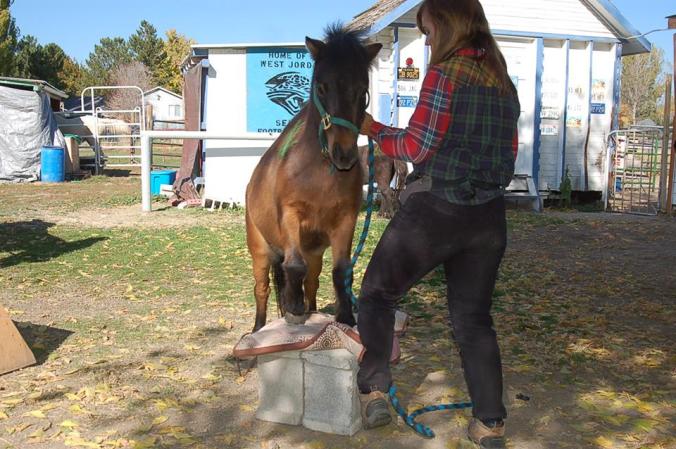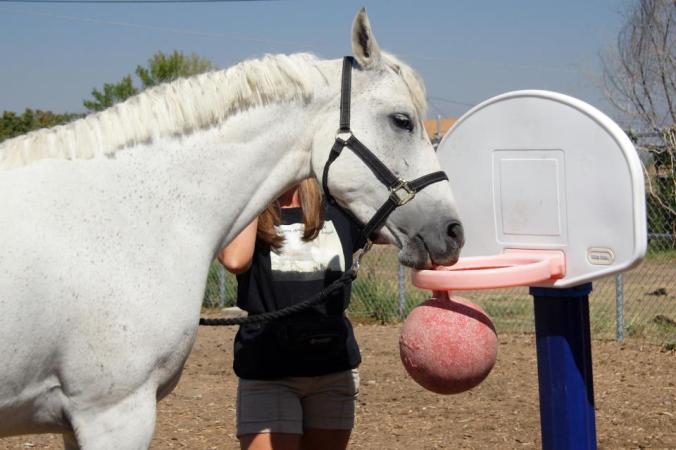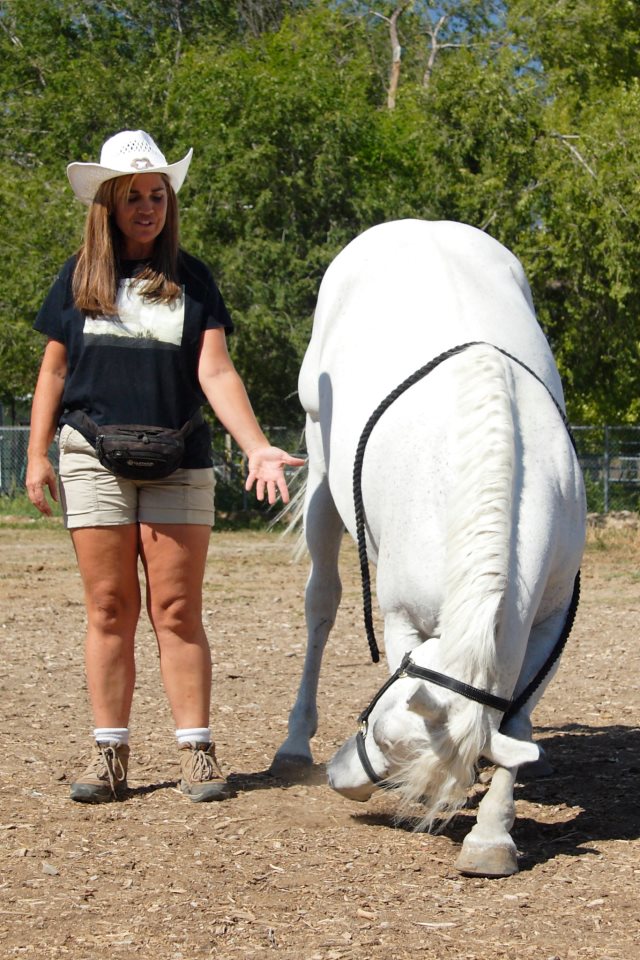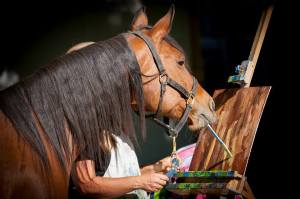So, how was your Thanksgiving? I actually wrote a blog last week but somehow lost it on my computer, and with the holiday going on I wasn’t able to get back to it. So I’ve written one similar to last week’s but a little different since I could not really remember everything I’d written.

Gypsy shows her not-so-pearly whites with a smile during a show.
If you want a good, dependable trick horse for showing, you more likely need a gelding. However, I do believe there can be dependable mares too. I can see why there is the thought that mares are not dependable, because mares go through heat cycles and can become moody. Gypsy, my little Arabian, is very “mareish.” While Cheyenne doesn’t seem to be mareish, she is definitely an alpha mare and can be bossy but she is a great trick horse.
In a trick horse, you need one who is dependable for shows. If you are going to train a horse for your or your family’s pleasure, any horse will do. But if you want a horse for the pleasure of doing professional performances, you need a dependable horse such as a stallion, if you can control one, or a gelding. These horses are dependable. Another horse that could be a challenge to handle is the alpha mare type. I have one of those. I have been taking lessons in natural horsemanship on how to handle her but keep the relationship good. I am talking about disciplining them but in a more respectful manner rather than beating on them. It keeps her calm and relaxed and respectful of me at the same time. It is working.
However, Cheyenne has done many shows and in every one of those shows she has been very dependable. She makes a great trick horse even though she is a mare. However, the older horses who are grown make the better trick horses. Young horses have a shorter attention span, like children, and can’t focus on trick training like an adult horse can. There are exceptions to this sometimes. It also depends on how much time you are willing to spend on this young horse to grasp it. An example is Beautiful Jim Key, who was discussed in my previous posts. Horses are full grown when they are around five, six, or even seven. But three- and four-year old horses will probably be able to grasp the lessons more easily than a horse younger than that. At this age these horses are developed enough that their education, including trick training, can begin. They possess sufficient mental maturity and the ability to concentrate so that learning comes easily. So the age of the horse can be an important factor.
It is also important to note that older horses that are already very advanced in their training might find trick training a nice addition to their other training. These horses might make very grateful students because they are so happy to add variation to their regular routine. Let’s face it, you can teach an older horse new tricks. However, you might have to adjust the difficulty of the tricks when considering their age and physical limitations due to age and/or health and soundness.
The horse’s disposition and temperament is extremely important. Their dispositions or willingness to work may be changed by the way we work with the horse. But the horse’s temperament cannot be changed. A more nervous, flighty horse will probably be more difficult to train rather than a calm horse who is able to be at home in many different places. However, for the more flighty horse it will just take more time and patience from the trainer than on the calmer, more quiet horses. But the flighty horses can learn to do tricks and enjoy them. Good trainers can ride these horses and teach them to trust. We can also teach these more reactive type horses to trust us again when it comes to tricks. It just takes more time and patience. But that is what makes a great trainer, the ability to adjust to each horse’s individual needs.
However, there is the more hot-blooded horse. These horses are very smart but they can learn very fast because of that intelligence. They are more intelligent in the area of trick training. This means their education usually proceeds more quickly and their repertoire can be more comprehensive than that of their “cold-blooded” counterparts.

Any horse, large or small, can be taught to do tricks — such as the miniature Poochie here. (Photo by John G. Miller)
Any horse can learn to do tricks, large or small. But keep in mind there are some tricks a smaller horse will learn to do more easily than a large horse. For instance, laying down will be easier to learn for a smaller horse than a larger horse since the smaller horse is already closer to the ground. But horses just love to learn, large or small. Horses with injuries can learn tricks that are easier. There are so many ways a horse can learn to bow without going all the way to the ground. Gypsy, my older Arabian mare, just puts out her right front leg and touches it with her nose. She loves that trick. Not only does it look classy, it is very easy for the horse who is uncomfortable about going to the ground with a bow. The audience will love it just the same.
So whatever horse you are using, just remember to enjoy, gear it to what they can physically and mentally handle, plus the most important thing is to have fun with your equine friend. It is all about enjoying time together and keeping a wonderful relationship alive with your horse.






